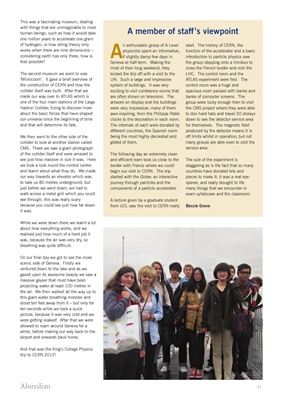
This was a fascinating museum, dealing
with things that are unimaginable to most
human beings, such as how it would take
one million years to accelerate one gram
of hydrogen, or how string theory only
works when there are nine dimensions -
considering earth has only three, how is
that possible?
The second museum we went to was
'Microcosm'. It gave a brief overview of
the construction of CERN and how the
collider itself was built. After that we
made our way over to ATLAS which is
one of the four main stations of the Large
Hadron Collider, trying to discover more
about the basic forces that have shaped
our universe since the beginning of time
and that will determine its fate.
We then went to the other side of the
collider to look at another station called
CMS. There we saw a giant photograph
of the collider itself and were amazed to
see just how massive in size it was. Here
we took a look round the control centre
and learnt about what they do. We made
our way towards an elevator which was
to take us 80 metres underground, but
just before we went down, we had to
walk across a metal grill which you could
see through; this was really scary
because you could see just how far down
it was.
While we were down there we learnt a lot
about how everything works, and we
realised just how much of a hard job it
was, because the air was very dry, so
breathing was quite difficult.
On our final day we got to see the more
scenic side of Geneva. Firstly we
ventured down to the lake and as we
gazed upon its awesome beauty we saw a
massive geyser that must have been
projecting water at least 100 metres in
the air. We then walked all the way up to
this giant water breathing monster and
stood ten feet away from it - but only for
ten seconds while we took a quick
picture, because it was very cold and we
were getting soaked! After that we were
allowed to roam around Geneva for a
while, before making our way back to the
airport and onwards back home.
And that was the King's College Physics
trip to CERN 2012!
Aluredian 31
A
n enthusiastic group of A Level
physicists spent an informative,
if slightly damp few days in
Geneva at half-term. Making the
most of their long weekend, they
kicked the trip off with a visit to the
UN. Such a large and impressive
system of buildings. It was very
exciting to visit conference rooms that
are often shown on television. The
artwork on display and the buildings
were very impressive, many of them
awe-inspiring, from the Philippe Patek
clocks to the decoration in each room.
The internals of each were donated by
different countries, the Spanish room
being the most highly decorated and
gilded of them.
The following day an extremely clean
and efficient tram took us close to the
border with France where we could
begin our visit to CERN. The trip
started with the Globe: an interactive
journey through particles and the
components of a particle accelerator.
A lecture given by a graduate student
from UCL saw the visit to CERN really
start. The history of CERN, the
function of the accelerator and a basic
introduction to particle physics saw
the group stepping onto a minibus to
cross the French border and visit the
LHC. The control room and the
ATLAS experiment were first. The
control room was a huge and
spacious room packed with banks and
banks of computer screens. The
group were lucky enough then to visit
the CMS project where they were able
to don hard hats and travel 30 storeys
down to see the detector service area
for themselves. The magnetic field
produced by the detector means it is
off limits whilst in operation, but not
many groups are able even to visit the
service area.
The size of the experiment is
staggering as is the fact that so many
countries have donated bits and
pieces to make it; it was a real eyeopener,
and really brought to life
many things that we encounter in
exam syllabuses and the classroom.
Beccie Grove
A member of staff's viewpoint